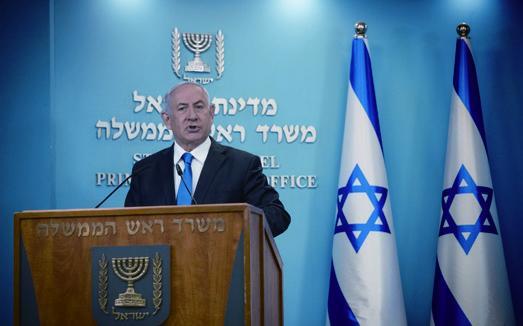End of Pan-Arabism?
By Wang Jin

The peace deal reached between the United Arab Emirates (UAE) and Israel on August 13 is a milestone in the relations between the Arab world and Israel. It also marks the start of a new era of pan-Arabism.
The deal means, to a large extent, Abu Dhabi abandoning the Arab Peace Initiative of 2002. In 2002, Saudi Arabia, together with other Arab states, called for total peace and normalization of ties with Israel under the precondition of a final peace between Israel and Palestine. But now, by agreeing to formally normalize relations with Israel, the UAE has given up that precondition.
Long-lasting conflicts
The Palestinian issue had been at the core of the confl ict between Israel and the Arab world since World War I. Britains 1917 Belfour Declaration announcing support for the establishment of a “national home for the Jewish people” in Palestine was strongly rejected by the Arabs, and the founding of modern Israel in 1948 unleashed long-time confl icts and wars in the region.
In several wars between Israel and the Arab world from the 1940s to the 1980s, each side pushed opposite claims. Israel thought the Arab world should respect its legal status as a state, while the Arab world fundamentally challenged its legitimacy and maintained that the whole of Palestine should be liberated militarily.
Under the banner of pan-Arabism, different Arab states united, although mostly with different strategic goals, and launched war on Israel. In the First Arab-Israeli War in 1948, Palestinians thought the newly born Israel state would be easily defeated by the armies co-organized by different“Arab brother” states. Even after the Israeli victory, the Palestinian refugees in Egypt, Jordan and Syria believed that it would not be too long before they returned home, due to the support from other Arab states.
However, wars and conflicts did not lead to military and political victories, while internal frictions and crises in different Arab states hindered the unity. Different ideologies influencing different Arab states also caused the Arab cooperation to deteriorate. The secular Arab nationalism advocated by then Egyptian President Gamal Abdel Nasser intensified the tension with the Gulf Arab states that upheld the monarchical system. The competition between the two camps was so salient that it fi nally led to a proxy war in Yemen in the 1960s, and to an extent led to Arab statesdefeat in the 1967 war with Israel.
The defeat made the Arab world realize that it might not be possible to expel Israelis from Palestine, as had been expected in the 1950s. Israel occupied entire Palestine with strong military capabilities that could not be defeated by Arab states.
Therefore, after the 1967 war, especially after the death of Nasser in 1970, Egypt started to adjust its strategies. Under the leadership of Muhammad Anwar el-Sadat, the tension between Egypt and Israel was largely mitigated, and a final peace deal was made in 1979 under Washingtons mediation.
Although this was strongly rejected by other Arab states led by Syria and Iraq, and Sadat was killed in 1981 by extremists, the agreement was not scrapped by Sadats successors. The Palestinian issue is still an important and sensitive topic for Egypt and Israel, but the peace remains.
After the Israel-Palestine peace process began in the early 1990s, the ties between Israel and Jordan witnessed a major breakthrough in 1994 with the signing of a bilateral peace deal.
With the peace process facing a dilemma in the 2000s, the Palestinian issue again became an important obstacle for ties between Israel and the Arab world. Following the second Palestinian uprising against Israels occupation of the West Bank and Gaza Strip in 2000, the 2006 Lebanon War and Israels military strikes on the Gaza Strip, Israel was widely criticized by the Arab world and the normalization of ties seemed impossible.

Focus shift
The so-called Arab Spring movement of 2011 signifi cantly changed the geopolitics in the Middle East and the Palestinian issue was largely marginalized. The domestic crises, especially the political and social movements organized by the Muslim Brotherhood and other Islamic political groups in Egypt, Jordan, Syria and other Arab states, forced Arab leaders to focus on their own internal affairs. Meeting the demands of their own people and considering the political aspirations of challengers at home became more pressing issues.
External threats, especially the perceived threat from Iran, also significantly reshaped the geopolitical landscape in the region. Irans traditional geopolitical competitors, the Taliban in Afghanistan in the east and Saddam Husseins regime in Iraq in the west, were overthrown by the U.S. in 2001 and 2003, respectively. After 2011, major Arab powers such as Egypt and Syria were weakened by internal un- rest and chaos, while the regional infl uence of Iran expanded rapidly. In Syria, government forces and other groups supported by the Iranian Revolutionary Guards Corps became dominant. In Yemen, the ties between the Houthi insurgent group and Tehran were further consolidated, and the rise of the Houthi became a major threat to Saudi Arabia. The Iran-supported militant group Hezbollah became more assertive in south Lebanon.
Traditionally, the U.S. was a dominant power in the region that carefully balanced the states in the Middle East. The U.S. intervention in Kuwait during the 1990-91 Gulf War after it was invaded by Iraq under Saddam Hussein successfully thwarted the regional ambitions of Iraq. However, from the second term of President George W. Bush, U.S. interest and infl uence in the Middle East apparently declined.
On one hand, the U.S. military presence in Iraq and Afghanistan did not lead to stability and political unity in local governments, which shook U.S. confidence and capabilities in the region. On the other hand, the U.S. under President Donald Trumps administration upheld the America First principle and started to withdraw from the Middle East. The signing of a peace deal between the U.S. and the Taliban in February suggested Trump was losing interest in the region.
Against this backdrop, it is necessary for the states in the Middle East to reform their ties to face new internal and external challenges. As a state aiming to become the regional center with its exploration of advanced technologies and the financial sector, the UAE hopes to absorb Israels power of innovation and the global Jewish fi nancial network. Also, the UAEs weak military capabilities dictate forming an alliance, or quasi-alliance, with Israel to confront the external challenges, especially from its near neighbor Iran.

